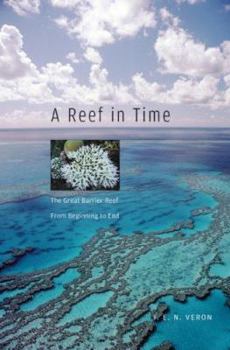A Reef in Time: The Great Barrier Reef from Beginning to End
Select Format
Select Condition 
Book Overview
Like many coral specialists fifteen years ago, J. E. N. Veron thought Australia's Great Barrier Reef was impervious to climate change. "Owned by a prosperous country and accorded the protection it... This description may be from another edition of this product.
Format:Hardcover
Language:English
ISBN:0674026799
ISBN13:9780674026797
Release Date:January 2008
Publisher:Belknap Press
Length:289 Pages
Weight:1.45 lbs.
Dimensions:1.2" x 6.4" x 9.4"
Customer Reviews
3 ratings
Interesting, Touching, but Terrifying
Published by Thriftbooks.com User , 15 years ago
This book was awesome and proved very informative and I would highly recommend it, however the last couple of pages are where the author gives you their personal opinion (I do believe they earned their right to do so)and it is a bit of downer. Their personal outlook on the future of the coral reefs is rather bleak and suggests that within my generation's lifetime if not their own the reefs will disappear for the extension of the human race's existence. This however, arguably, makes the book of greater importance, because if people don't know then they will never be able to care.
An Unfortunate Reality
Published by Thriftbooks.com User , 16 years ago
In "A Reef in Time: The Great Barrier Reef from Beginning to End" the highly respected coral reef expert J. E. N. Veron describes both the history of reefs in general and the Great Barrier Reef in particular. Certainly this book is not exactly uplifting because it outlines the future end of the reef, not in space, but in time. This end is to a large part premature and almost certainly to be brought on by human activity. As Veron notes reefs have come and gone throughout the history of the earth, appearing in the Devonian, Permian and Triassic, only to be destroyed in mass extinction events. New and different reefs returned, but not until after hundreds of thousands to millions of years. On both sides of the Rio Grande Valley, where I now live, are immense remains of middle Permian reefs, all of which disappeared in that mother of all extinction events which marks the Permian-Triassic boundary. The reefs now stand over 4000 feet above sea level, a monument to impermanence. Such would eventually be the fate of the monumental Great Barrier Reef, but in tens of thousands of years at least. The activities of humans (in causing global warming, direct damage to reefs and acidification of the oceans) may now cause the same destruction in hundreds of years or less. What is to be done? Venon thinks that there is some cause for hope, but I am unsure that that such hope is warranted. In this I would like to be wrong. However I see no political will on the part of either governments or populations to curb their activities in time before tipping points are reached that commit us to a major disruption of the planet. In essence we in the United States have wasted nearly eight years that we really did not have because of an administration that preferred wishful thinking to reality. Still I cannot just blame the United States as even the European Union will not reach its own goals and China and India, among others, are hurrying to reach the same levels of greenhouse gas emissions as the developed world. Venon has written a thoughtful and well documented book that will certainly educate the reader in the current knowledge of reefs and the likely result of our current predicament. I recommend it, but be aware that you may find it depressing, despite Venon's attempts to be upbeat.
An instructive read on a depressing topic
Published by Thriftbooks.com User , 16 years ago
Excellent overview of the Great Barrier Reef's history. The text flows, is extremely easy to read, and the chapters and headings are set out logically. Much of the background involves controversial theories (e.g. reasons for major extinctions), and these, among others, are discussed thoroughly and with sufficient maps, given the relatively short length and overall scope of the book. The important points (carbon dioxide and ocean acidification) are drilled home repeatedly without a loss of their impact. It is clear that the target audience for this book is for newcomers to the fields of coral research or paleontology. The only major flaw I see in the book are the many identical diagrams and photographs from previous publications by Dr. Veron, but, for those who pick up this book with no prior knowledge, this same information must be novel and informative. Even for those who have a background in the above fields, there is enough new information in this book to satisfy, and a few veritable gems of insight and observation. This book has a few ideas which people may or may not agree with Dr. Veron, but it is well-researched and well-argued. The overriding message presented in the final chapters is certainly the focus of the book, and in the end, the other details which may or may not be correct rightly take a back seat. Overall a recommended read.





